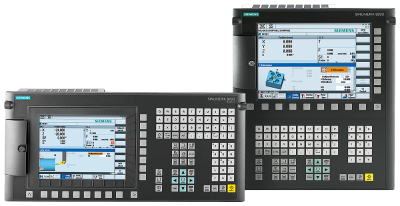
Siemens announced a new control-only retrofit program for CNC machines. Tailored precisely for milling machines up to four axes plus one spindle or 2- to 3-axis turning machines, users can gain new levels of manufacturing efficiency and productivity. By retrofitting an aging machine tool with a new CNC, users can quickly improve their productivity, cut soaring maintenance costs and greatly extend the machine tool’s lifecycle, according to the company.
The Sinumerik 828D control is a panel-based CNC with horizontal and vertical control panel layouts. It’s small enough to be easily integrated into the most compact machine tool designs. Now with support for analog drive connectivity, the Sinumerik 828D is a durable, rugged and user-friendly control with an intuitive graphical user interface for programming and operation. With no hard disk or fan, the 828D is maintenance-free and it features a 10.4” color TFT display, a full QWERTY keyboard and a number of communication interfaces including Ethernet, USB 2.0, Compact Flash (CF) card, Drive-Cliq, RS232 C, PLC I/O and NC I/O.
Contact Details
Related Glossary Terms
- computer numerical control ( CNC)
computer numerical control ( CNC)
Microprocessor-based controller dedicated to a machine tool that permits the creation or modification of parts. Programmed numerical control activates the machine’s servos and spindle drives and controls the various machining operations. See DNC, direct numerical control; NC, numerical control.
- flash
flash
Thin web or film of metal on a casting that occurs at die partings and around air vents and movable cores. This excess metal is due to necessary working and operating clearances in a die. Flash also is the excess material squeezed out of the cavity as a compression mold closes or as pressure is applied to the cavity.
- gang cutting ( milling)
gang cutting ( milling)
Machining with several cutters mounted on a single arbor, generally for simultaneous cutting.
- milling
milling
Machining operation in which metal or other material is removed by applying power to a rotating cutter. In vertical milling, the cutting tool is mounted vertically on the spindle. In horizontal milling, the cutting tool is mounted horizontally, either directly on the spindle or on an arbor. Horizontal milling is further broken down into conventional milling, where the cutter rotates opposite the direction of feed, or “up” into the workpiece; and climb milling, where the cutter rotates in the direction of feed, or “down” into the workpiece. Milling operations include plane or surface milling, endmilling, facemilling, angle milling, form milling and profiling.
- numerical control ( NC)
numerical control ( NC)
Any controlled equipment that allows an operator to program its movement by entering a series of coded numbers and symbols. See CNC, computer numerical control; DNC, direct numerical control.
- turning
turning
Workpiece is held in a chuck, mounted on a face plate or secured between centers and rotated while a cutting tool, normally a single-point tool, is fed into it along its periphery or across its end or face. Takes the form of straight turning (cutting along the periphery of the workpiece); taper turning (creating a taper); step turning (turning different-size diameters on the same work); chamfering (beveling an edge or shoulder); facing (cutting on an end); turning threads (usually external but can be internal); roughing (high-volume metal removal); and finishing (final light cuts). Performed on lathes, turning centers, chucking machines, automatic screw machines and similar machines.








